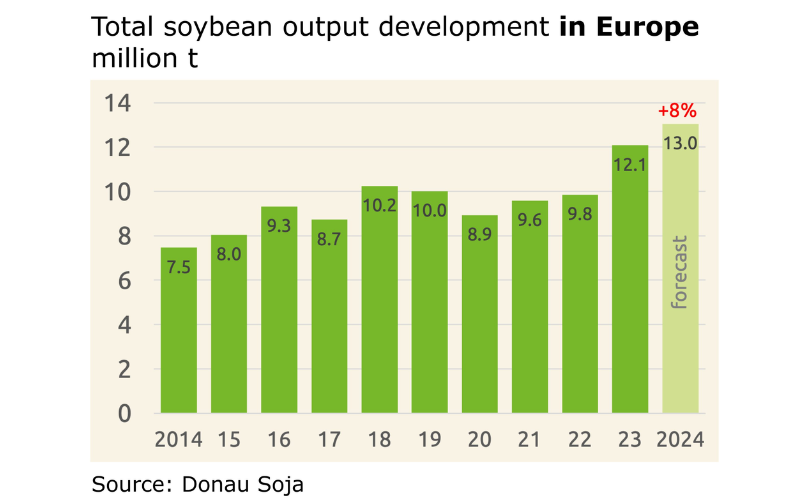Massive increases in Ukraine, but some dramatic weather-related losses in Central Europe and the Balkans
Vienna. The soybean harvest in Europe has increased by almost one million tonnes to more than 13 million tonnes this year compared to 2023, according to the new Donau Soja Market Report for November. This record figure is due to a massive 44% increase in cultivation area and a record harvest in Ukraine of more than 6 million tonnes – an increase of around 25%. In the EU, the cultivation area increased by 10% compared to 2023, but the EU harvest fell by 3.4% to just under 2.8 million tonnes. This is due to lower yields per hectare in Central Europe and some Balkan countries as a result of the summer heat and drought. Serbia and Romania are particularly affected this year, with yields per hectare expected to be up to 50% lower than last year. “The increased area under soya cultivation in Europe and the strong harvest in Ukraine can compensate for the losses caused by the extreme weather conditions in the EU and parts of south-eastern Europe and will lead to an overall record harvest of more than 13 million tonnes of soya in Europe”, says Susanne Fromwald, General Secretary of Donau Soja.
Slight decline in harvests in Austria and Germany
Expectations for Austria were lowered by more than 11% to 240,000 tonnes due to the extreme rainfall last September, as entire fields were washed away. However, the yield per hectare is in line with the long-term average and the quality of the beans is consistently good. In Germany, the area under cultivation fell by 10%, but the harvest fell by only 3.1% to 125,000 tonnes due to the very good yields per hectare. “We definitely see great potential for increasing the soya area cultivation in Germany, last but not least with new varieties that can also grow further north”, says Fromwald.
Ukraine is Europe’s largest soya producer
As in previous years, Ukraine remains to be the largest and most important European producer of soya, benefiting to the EU livestock sector. The soya cultivation area in 2024 was 2.6 million hectares, which is an increase of almost 44% compared to 2023. According to the Ukrainian Ministry of Agriculture, Donau Soja experts estimate the total harvest to exceed six million tonnes. Around ten percent of this will be certified according to Donau Soja Standards. “The EU is currently only 8% self-sufficient in soya. GMO-free Donau Soja certified soya from Ukraine helps to fill the large gap in protein crops in Europe. Certified Ukrainian and EU soybeans are also produced to the same strict standards by Donau Soja, so they are not ‘cheap competition’ for farmers in EU countries”, says Fromwald.
One million tonnes of soya in Europe certified according to Donau Soja standards
In total, around one million tonnes of the more than 13 million tonnes of soya produced in Europe in 2024 were certified according to the strict standards of Donau Soja, i.e. non-GMO, verified deforestation and conversion-free, reduced pesticide use and international labour law standards were met.
Global soya production in the 2024/2025 marketing year is estimated to total 425 million tonnes. The EU imports around 35 million tonnes of soya every year. The majority of these imports are genetically modified soya from overseas, which is used as animal feed, and jeopardises regions such as the Cerrado savannah or the Gran Chaco.
Link to Donau Soja Market Report
Download photo Susanne Fromwald
Download graph of soybean output in Europe
Download graph of soybean output in Ukraine
Download this press release
For the newest Donau Soja Market Report November please refer to petri@donausoja.org.
Further enquiries and interview requests:
Franko Petri
Head of Communications, Donau Soja
Wiesinger Strasse 6/14, 1010 Vienna, Austria
Mobile: +43 664 889 61 298
Email: petri@donausoja.org and presse@donausoja.org
Website: www.donausoja.at



